Analyzing the Impacts of Sewer Type and Spatial Distribution of LID Facilities on Urban Runoff and Non-Point Source Pollution Using the Storm Water Management Model (SWMM)
Abstract
:1. Introduction
2. Methods
2.1. Description of SWMM
2.2. Study Area and Input Data
2.3. Evaluation of Runoff and NPS Pollution Loads Estimation by Using Sewer Type
2.4. Application of LID Techniques in SWMM
2.5. Evaluation of Runoff and NPS Pollution Loads Estimation from LID Scenarios Application
3. Results and Discussion
3.1. Comparison of Runoff and NPS Pollution Load by Sewer Type
3.2. Analysis of Runoff and NPS Pollution Loads Impacts in LID Scenarios
4. Conclusions
- (1)
- When the characteristics of each sewer type were simulated, 68% of the rainfall (1284.1 mm) was discharged for separate sewers, 49% for combined sewers with storage tanks, and 79% for combined sewers without a storage tank. Combined sewers without storage tank showed the highest BOD and TP loads, followed by combined sewers with storage tank and separate sewers. Combined sewers exhibited higher pollution loads than separate sewers due to the influence of sewage during rainfall.
- (2)
- The LID scenario analysis results showed that distributed LID installation, as in scenario 1, was the most effective for minimizing the flow and pollution loads introduced into sewer pipes. Despite differences depending on the sewer type, the hydrological cycle improvement effect was up to four times higher when LID facilities were uniformly distributed in the watershed compared to when they were intensively installed. Furthermore, distributed installation of LID facilities in the combined sewer watershed showed the highest reduction efficiency. When LID facilities were intensively installed in the watershed, installation in downstream areas was more effective than in upstream and midstream areas.
- (3)
- The application of permeable pavements and the Tree Box filter contributed to the recovery of the hydrological cycle by reducing the runoff, due to infiltration and storage. Under the parameter conditions applied in this study, there was no significant difference in the runoff reduction and water quality improvement effect between permeable pavements and the Tree Box filter. Therefore, future studies will additionally evaluate the effectiveness of permeable pavement and Tree Box filters in other watersheds.
- (4)
- The results of this study indicate the hydrological cycle improvement effect can be enhanced through the effective installation of LID facilities along with the understanding of sewer characteristics in a watershed. This means that this study contributes a new approach that will use for future urban planning, guide the effective type and distribution of LID facilities, and alleviate runoff and NPS pollution load. These findings can be applied to other areas with a high ratio of impervious surfaces. In future studies, research on effective hydrological cycle improvement will be conducted through further verification in other watersheds, such as dense urban and urban-rural areas. In this study, there is a limitation in analyzing the sewer types and LID facilities with the setting of the virtual watershed compared to the actual watershed. Therefore, In the future study, in the case of an actual watershed, studies on the reasonable parameter estimation of SWMM and watershed characteristics will be considered. The economic effect of LID facility selection planning compared to its cost will be analyzed for each sewer type.
Author Contributions
Funding
Institutional Review Board Statement
Informed Consent Statement
Data Availability Statement
Conflicts of Interest
References
- Kaykhoravi, S.; Khan, U.; Jadidi, M. The effect of climate change and urbanization on the demand for low-impact development for three Canadian cities. Water 2020, 12, 1280. [Google Scholar] [CrossRef]
- Lee, J.; Lee, S.; Hong, J.; Lee, D.; Bae, J.H.; Yang, J.E.; Kim, J.; Lim, K.J. Evaluation of rainfall erosivity factor estimation using machine and deep learning models. Water 2021, 13, 382. [Google Scholar] [CrossRef]
- Lee, J.; Park, Y.S.; Jung, Y.; Cho, J.; Yang, J.E.; Lee, G.; Kim, K.S.; Lim, K.J. Analysis of spatiotemporal changes in groundwater recharge and baseflow using SWAT and BFlow Models. J. Korean Soc. Water Environ. 2014, 30, 549–558. [Google Scholar] [CrossRef]
- Lee, J.; Shin, Y.; Park, Y.S.; Kum, D.; Lim, K.J.; Lee, S.O.; Kim, H.; Jung, Y. Estimation and assessment of baseflow at an ungauged watershed according to land use change. Wetl. Res. 2014, 16, 303–318. [Google Scholar]
- Xue, J.; Wang, Q.; Zhang, M. A review of non-point source water pollution modeling for the urban-rural transitional areas of China: Research status and prospect. Sci. Total Environ. 2022, 826, 1–13. [Google Scholar] [CrossRef]
- Armstrong, D.S.; Richards, T.A.; Levin, S.B. Factor Influencing Riverine Fish Assemblages in Massachusetts; U.S. Geological Survey Scientific Investigations Report; U.S. Geological Survey: Reston, VA, USA, 2011; pp. 2011–5193.
- Bellucci, C. Stormwater and aquatic life: Making the connection between impervious cover and aquatic life impairments for TMDL development in Connecticut streams. In Proceedings of the Water Environment Federation TDML Conference, Bellevue, WA, USA, 24–27 June 2007; Water Environment Federation: Alexandria, VA, USA, 2007; pp. 1003–1018. [Google Scholar]
- Fogaca, F.N.; Gomes, L.C.; Higuti, J. Percentage of impervious surface soil as indicator of urbanization impacts in neotropical aquatic insects. Neotrop. Entomol. 2013, 42, 483–491. [Google Scholar] [CrossRef]
- Scheler, T. The Importance of imperviousness. Watershed Protect. Tech. 1994, 1, 100–111. [Google Scholar]
- Zheng, Q.; Hao, L.; Huang, X.; Sun, L.; Sun, G. Effects of urbanization on watershed evapotranspiration and its components in Southern China. Water 2020, 12, 645. [Google Scholar] [CrossRef]
- Cosgrove, W.; Loucks, D. Water management: Current and future challenges and research directions. Water Resour. Res. 2015, 51, 4823–4839. [Google Scholar] [CrossRef]
- Ryu, J.; Choi, J.Y.; Lee, J.M.; Shin, D.S.; Kim, J.S.; Jang, H.S.; Park, J.H.; Jeong, Y.J.; Ryu, H.D.; Lee, J.K. Customized Policy Support for Nonpoint Pollution Management and Water Circulation Improvement (III); NIER-RP2018–248; National Institute of Environmental Research: Incheon, Korea, 2018; pp. 1–97. [Google Scholar]
- Park, M.; Lee, J.M.; Choi, J.Y.; Kim, J.S.; Park, B.K.; Ryu, J.; Lee, S.Y.; Kim, K.H.; Lee, J.K. Customized Policy Support for Nonpoint Pollution Management and Water Circulation Improvement (V); NIER-RP2020-289; National Institute of Environmental Research: Incheon, Korea, 2020; pp. 1–30. [Google Scholar]
- Lin, J.Y.; Yuan, T.C.; Chen, C.F. Water retention performance at low-impact development (LID) field sites in Taipei, Taiwan. Sustainability 2021, 13, 759. [Google Scholar] [CrossRef]
- Kim, J.M.; Baek, J.S.; Shin, H.S. A study on improvement of hydrologic cycle by selection of LID technology application area. Korea Acad. Ind. 2021, 22, 545–553. [Google Scholar]
- Kim, B.S.; Kim, J.M.; Kim, S.S.; Shin, G.W.; Lee, S.J. A study on runoff reduction according to the calculation method of the LID scale considering the land use area and the application of stormwater storage basin. Civ. Environ. Eng. Res. 2021, 41, 229–235. [Google Scholar]
- Perez-Pedini, C.; Limbrunner, J.; Vogel, R. Optimal location of infiltration based best management practices for storm water management. J. Water Resour. Plan. Manag. 2005, 131, 441–448. [Google Scholar] [CrossRef]
- Joo, J.; Lee, Y.; Cho, H.; Kim, J. Analysis of long-term runoff reduction effects by installation of street tree box. J. Korean Soc. Hazard Mitig. 2012, 12, 193–197. [Google Scholar] [CrossRef] [Green Version]
- Shin, H.; Kim, M.; Kim, J.; Jang, J. Study on analysis of the proper ratio and the effects of low impact development application to sewage treatment district. J. Korea Water Resour. Assoc. 2013, 46, 1193–1207. [Google Scholar] [CrossRef]
- Park, Y.S.; Lee, J.; Jung, Y.; Shin, M.H.; Park, J.H.; Ryu, J.; Park, J.; Kim, K.S. Evaluation of regression models in LOADEST to estimate suspended solid load in Hangang waterbody. J. Korean Soc. Agric. Eng. 2015, 57, 37–45. [Google Scholar]
- Lee, S.; Kim, D.; Maeng, S.; Azam, M.; Lee, B. Runoff reduction effects at installation of LID facilities under different climate change scenarios. Water 2022, 25, 1301. [Google Scholar] [CrossRef]
- Jemberie, M.; Melesse, A. Urban flood management through urban land use optimization using LID techniques, city of Addis Ababa, Ethiopia. Water 2021, 13, 1721. [Google Scholar] [CrossRef]
- Yeon, J.S.; Kim, S.D.; Choi, H.I.; Shin, H.S.; Kim, E.S. Rainfall runoff reduction analysis for the construction and maintenance costs of LID facilities. J. Korean Soc. Hazard Mitig. 2015, 15, 281–287. [Google Scholar] [CrossRef]
- Lee, J.M.; Lee, Y.S.; Choi, J.S. Analysis of water cycle effect according to application of LID techniques. J. Wetl. Res. 2014, 16, 411–421. [Google Scholar] [CrossRef]
- Kim, E.S. Analysis of runoff according to application of SWMM_LID element technology (1): Parameter sensitivity analysis. J. Korean Soc. Hazard Mitig. 2020, 20, 437–444. [Google Scholar] [CrossRef]
- Park, S.Y.; Lee, K.W.; Park, I.H.; Ha, S.R. Effect of the aggregation level of surface runoff fields and sewer network for a SWMM simulation. Desalination 2008, 226, 328–337. [Google Scholar] [CrossRef]
- Kim, J.K.; Son, K.H.; Noh, J.W.; Jang, C.L.; Ko, I.H. Evaluation of urbanization effect and analysis of hydrological characteristics in the Gap River catchment using SWAT. J. Korea Water Resour. Assoc. 2006, 39, 881–901. [Google Scholar]
- Duchesne, S.; Mailhot, A.; Dequidt, E.; Villeneuve, J.P. Mathematical modeling of sewer overflows. Urban Water 2001, 3, 241–252. [Google Scholar] [CrossRef]
- Temprano, J.; Arango, O.; Cagiao, J.; Suarez, J.; Tejero, I. Stormwater quality calibration by SWMM: A case study in Northern Spain. Water SA 2006, 32, 55–63. [Google Scholar] [CrossRef]
- Montalto, F.; Behr, C.; Alfredo, K.; Wolf, M.; Arye, M.; Walsh, M. Rapid assessment of the cost effectiveness of low impact development for CSO Control. Landsc. Urban Plan. 2007, 82, 117–131. [Google Scholar] [CrossRef]
- Barco, J.; Wong, K.M.; Stenstorm, M.K. Automatic calibration of the US EPA SWMM model for a large urban catchment. J. Hydraul. Eng. 2008, 134, 466–474. [Google Scholar] [CrossRef]
- U.S. Environmental Protection Agency. Storm Water Management Model User’s Manual Version 5.1; U.S. Environmental Protection Agency: Washington, DC, USA, 2015; pp. 1–353.
- Abdy Aad, M.P.; Suidan, M.T.; Shuster, W.D. Modeling techniques of best management practices: Rain barrels and rain gardens using EPA SWMM-5. J. Hydrol. Eng. 2009, 15, 434–443. [Google Scholar] [CrossRef]
- Lee, Y.J.; Lee, C.Y. Analysis of the inflow characteristics of separate sewer systems for rainfall using an XP-SWMM Model and the SSOAP toolbox. J. Korean Soc. Hazard Mitig. 2021, 21, 271–280. [Google Scholar] [CrossRef]
- Park, M.; Lee, J.M.; Kim, J.S.; Lee, J.; Jang, H.S.; Shin, D.S.; Min, J.H.; Kim, K.H.; Kim, Y.S. Customized Policy Support for Nonpoint Pollution Management and Water Circulation Improvement (VI); NIER-RP2020-289; National Institute of Environmental Research: Incheon, Korea, 2021; pp. 1–30. [Google Scholar]
- Lee, H.W.; Choi, J.H. Analysis of rainfall-runoff characteristics in Shiwha industrial watershed using SWMM. J. Korean Soc. Environ. Eng. 2015, 37, 14–22. [Google Scholar] [CrossRef]
- Chae, J.Y. Study of Runoff Management Scheme in Urbanization Area Using XP-SWMM. Master’s Thesis, Paichai University, Daejeon, Korea, 2004. [Google Scholar]
- National Institute of Environmental Research. Evaluation of Non-Point Sources Loading (1) Impervious Land; NIER NO. 2006-34-816; Environmental Cap System Research Department, National Institute of Environmental Research: Incheon, Korea, 2006; p. 18. [Google Scholar]
- James, W.; Huber, W.C.; Dickinson, R.E.; Pitt, R.E.; James, W.R.C.; Roesner, L.A.; Aldrich, J.A. Users Guide to SWMM; CHI: Toronto, ON, Canada, 2005. [Google Scholar]
- Kang, T.; Lee, S. Development on an automatic calibration module of the SWMM for watershed runoff simulation and water quality simulation. J. Korea Water Resour. Assoc. 2014, 47, 343–356. [Google Scholar] [CrossRef]
- Lee, J.J.; Kim, H.N. Analysis of rainfall runoff reduction effect depending upon the location of detention pond in urban area. J. Korea Water Resour. Assoc. 2008, 28, 535–546. [Google Scholar]
- Yeon, J.S.; Jang, Y.S.; Lee, J.H.; Shin, H.S.; Kim, E.S. Analysis of stormwater runoff characteristics for spatial distribution of LID element techniques using SWMM. J. Korea Acad. Ind. Coop. Soc. 2014, 15, 3983–3989. [Google Scholar]
- Bae, D.H.; Jang, M.S. Development of adjusted subcatchment with equation in SWMM. J. Korea Water Resour. Assoc. 2009, 42, 105–115. [Google Scholar] [CrossRef]
- Lee, S.H.; Yoon, S.E.; Lee, J.J. A study on the determination of location of the detention pond in trunk sewer for reducing runoff amounts. J. Korea Water Resour. Assoc. 2017, 50, 223–232. [Google Scholar]
- Rossman, L.A. Storm Water Management Model User’s Manual Version 5.1; United States Environmental Protection Agency, Water Supply and Water Resources Division, National Risk Management Research Laboratory: Cincinnati, OH, USA, 2015.
- Center for Watershed Protection Technical Memorandum. The Runoff Reduction Method (CWPCSN). Appendix B—Derivation of Runoff Reduction Rates for Select BMPs; Center for Watershed Protection & Stormwater Network: Ellicott City, MD, USA, 2008; pp. B1–B11. [Google Scholar]
- Curtis, H. Low Impact Development Technical Guidance Manual for Puget Sound; Washington State University Pierce county Extension, Puget Sound Action Team: Tacoma, WA, USA, 2005; pp. 1–246.
- Geronimo, F.K.; Hong, J.; Kim, L.H. Hydrologic and hydraulic factors affecting the long term treatment performance of an urban stormwater tree box filter. J. Korean Soc. Water Environ. 2017, 33, 715–721. [Google Scholar]
- Brattebo, B.O.; Booth, D.B. Long-term stormwater quantity and quality performance of permeable pavement systems. Water Res. 2003, 37, 4369–4376. [Google Scholar] [CrossRef]
- Abbott, C.L.; Comino-Mateos, L. In-situ hydraulic performance of a permeable pavement sustainable urban drainage system. Water Environ. J. 2003, 17, 187–190. [Google Scholar] [CrossRef]
- Vailancourt, C.; Duchesne, S.; Pelletier, G. Hydrologic performance of permeable pavement as an adaptive measure in urban areas: Case studies near Montreal, Canada. J. Hydrol. Eng. 2019, 24, 1–10. [Google Scholar] [CrossRef]
- Geronimo, F.K.; Maniquiz-Redillas, M.C.; Hong, J.; Kim, L.H. Investigation on the factors affecting urban stormwater management performance of bioretention systems. J. Korean Soc. Water Environ. 2017, 33, 1–7. [Google Scholar]
- Hyun, K.H.; Kim, J.G.; Lee, J.M.; Lee, E.Y.; Kim, S.G.; Choo, Y.W.; Yoo, J.E. Installation Manual and Monitoring of LID-Decentralized Rainwater Management Facilities in Asan Tangjung; Land & Housing Institute: Daejeon, Korea, 2012. [Google Scholar]
- Zhang, K.; Chui, T.F.M. A comprehensive review of spatial allocation of LID=BMP-GI practices: Strategies and optimization tools. Sci. Total Environ. 2018, 621, 915–929. [Google Scholar] [CrossRef] [PubMed]
- Bakhshipour, A.E.; Dittmer, U.; Haghighi, A.; Nowak, W. Hybrid green-blue-gray decentralized urban drainage system design, a simulation-optimization framework. J. Environ. Manag. 2019, 249, 109364. [Google Scholar] [CrossRef] [PubMed]
- Wang, M.; Zhang, Y.; Zhang, D.; Zheng, Y.; Li, S.; Tan, S.K. Life-cycle cost analysis and resilience consideration for coupled grey infrastructure and low impact development practices. Sustain. Cities Soc. 2021, 75, 103358. [Google Scholar] [CrossRef]
- Roseen, R.; Ballestero, T.; Houle, J.; Avelleneda, P.; Wildey, R.; Briggs, J. Storm water low impact development, conventional structural, and manufactured treatment strategies for parking lot runoff: Performance evaluations under varied mass loading conditions. Transp. Res. Rec. 2006, 1984, 135–147. [Google Scholar] [CrossRef]
- Baek, J.; Kim, B.; Lee, S.; Kim, H. A study on application of LID technology for improvement of drainage capacity of sewer network in urban watershed. J. Korean Soc. Water Environ. 2017, 33, 617–625. [Google Scholar]
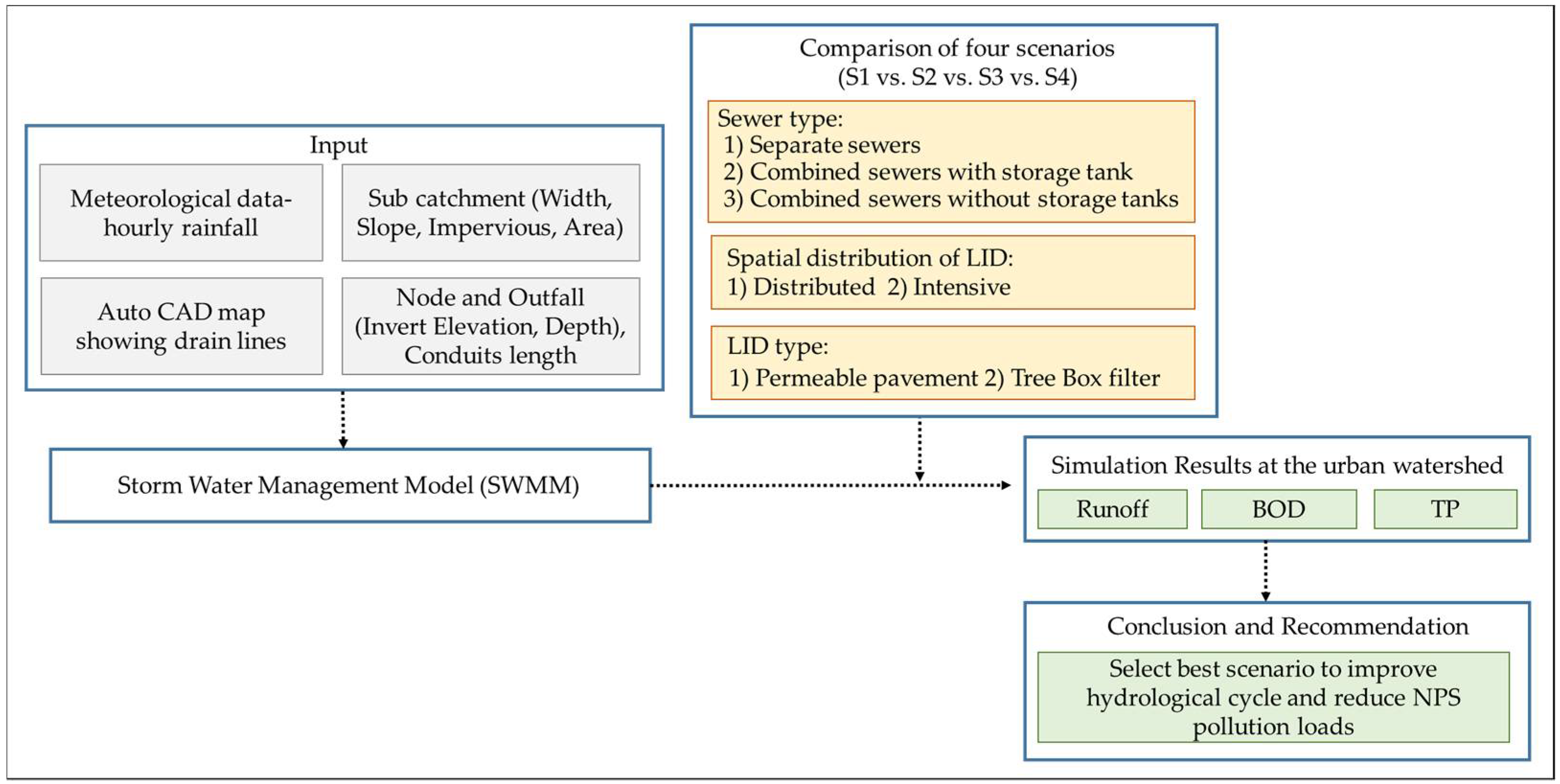
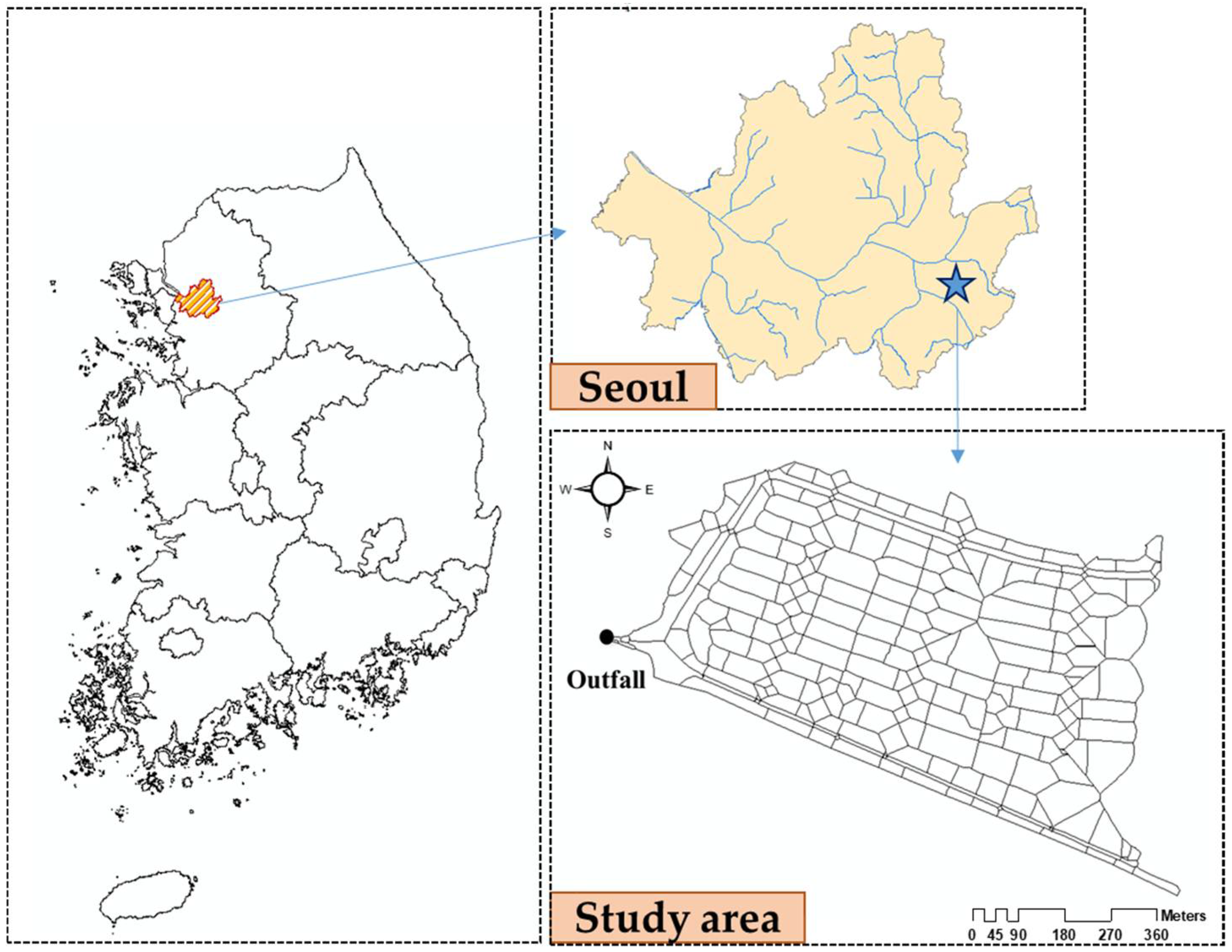
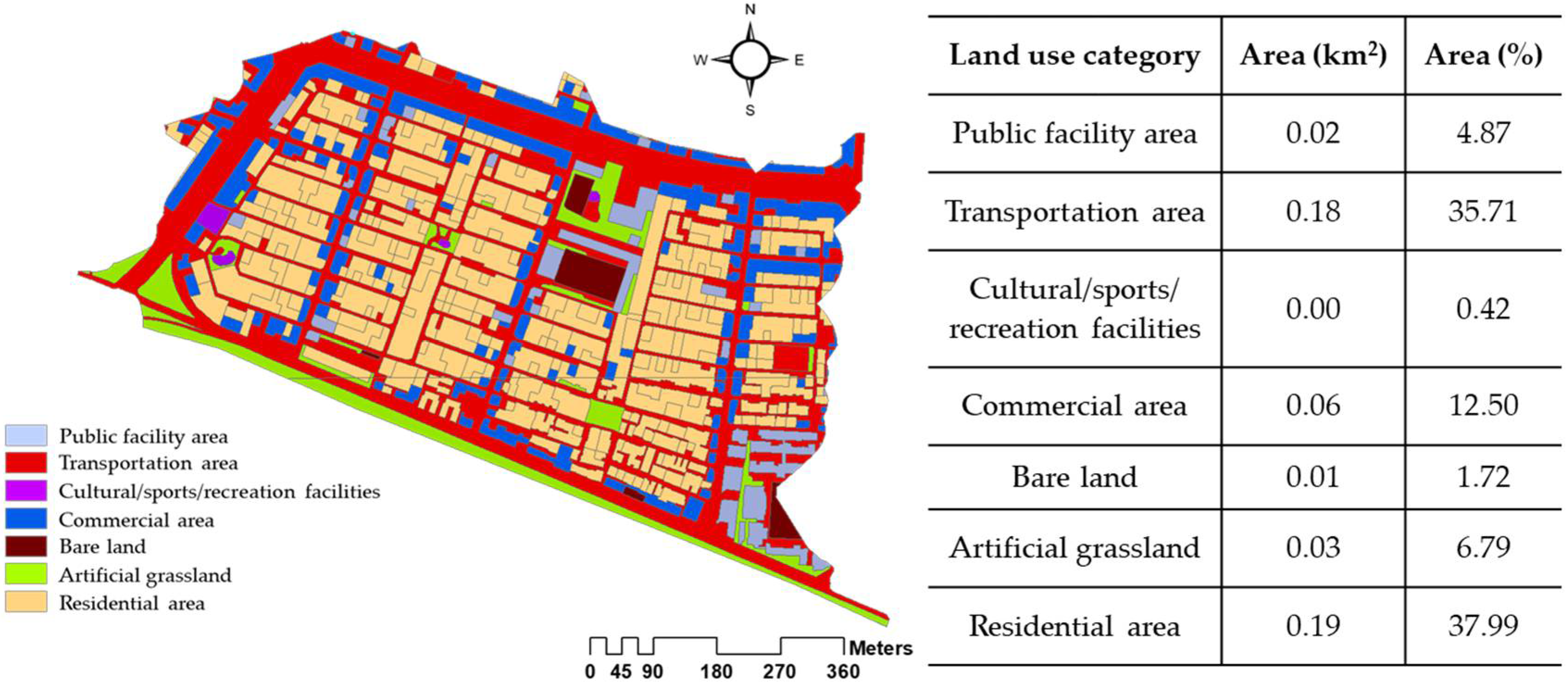
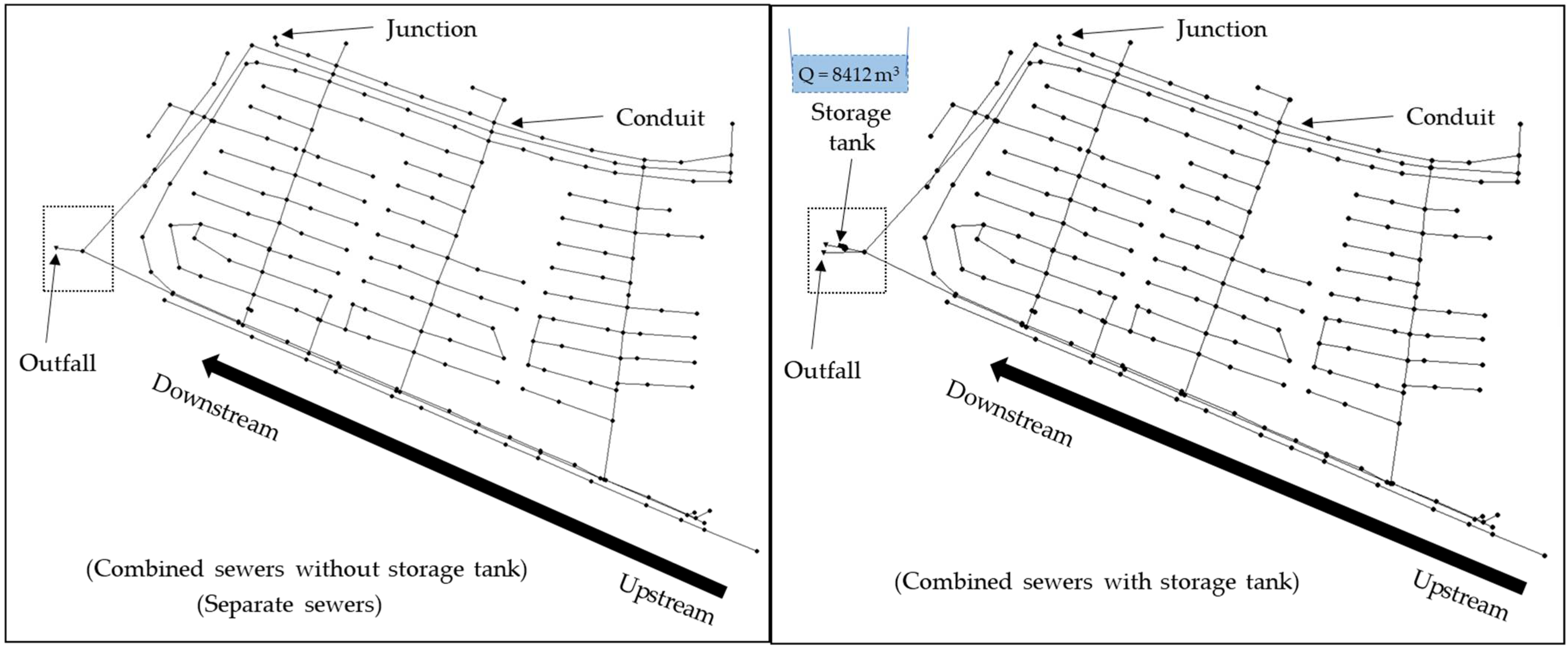

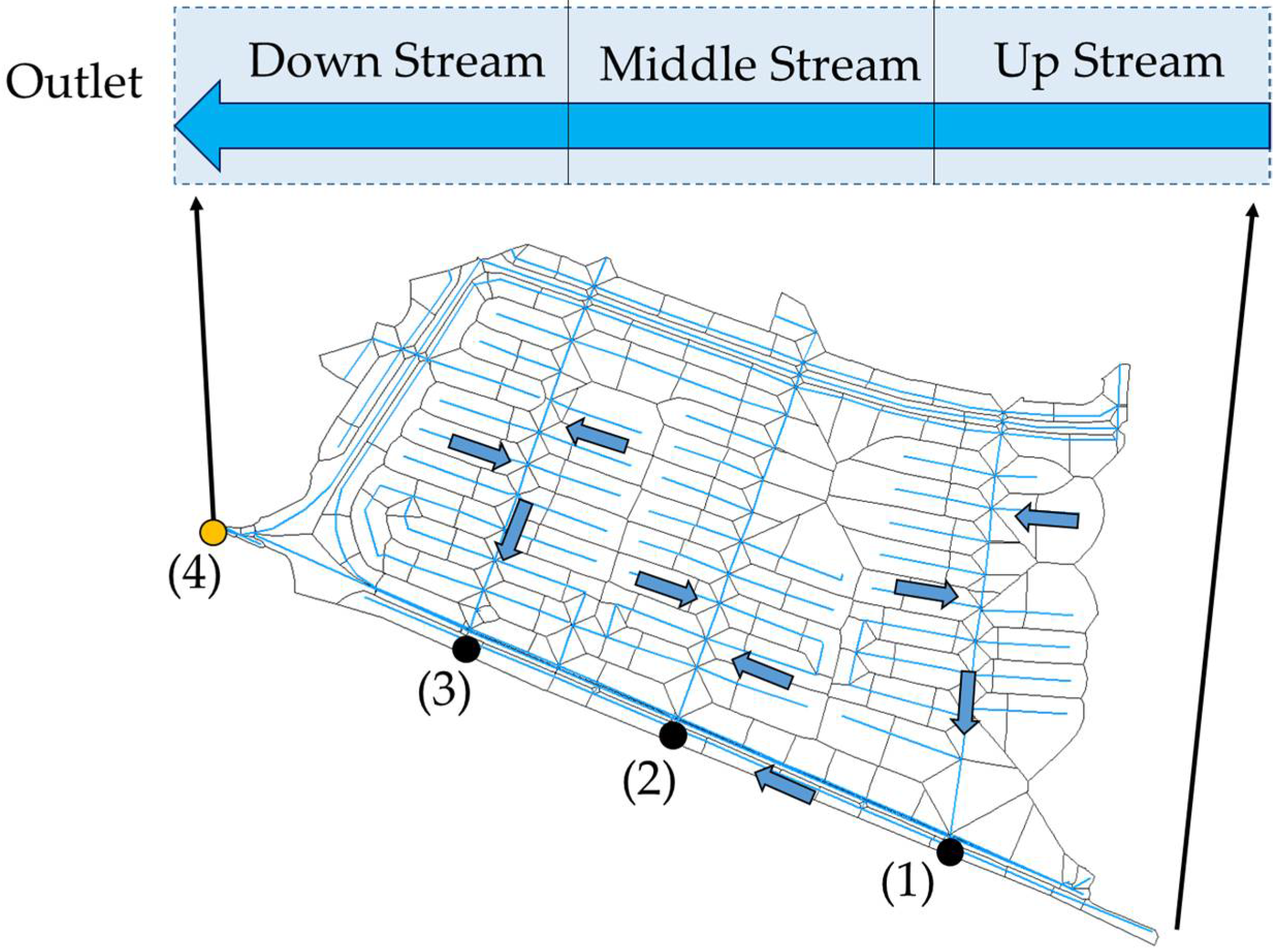
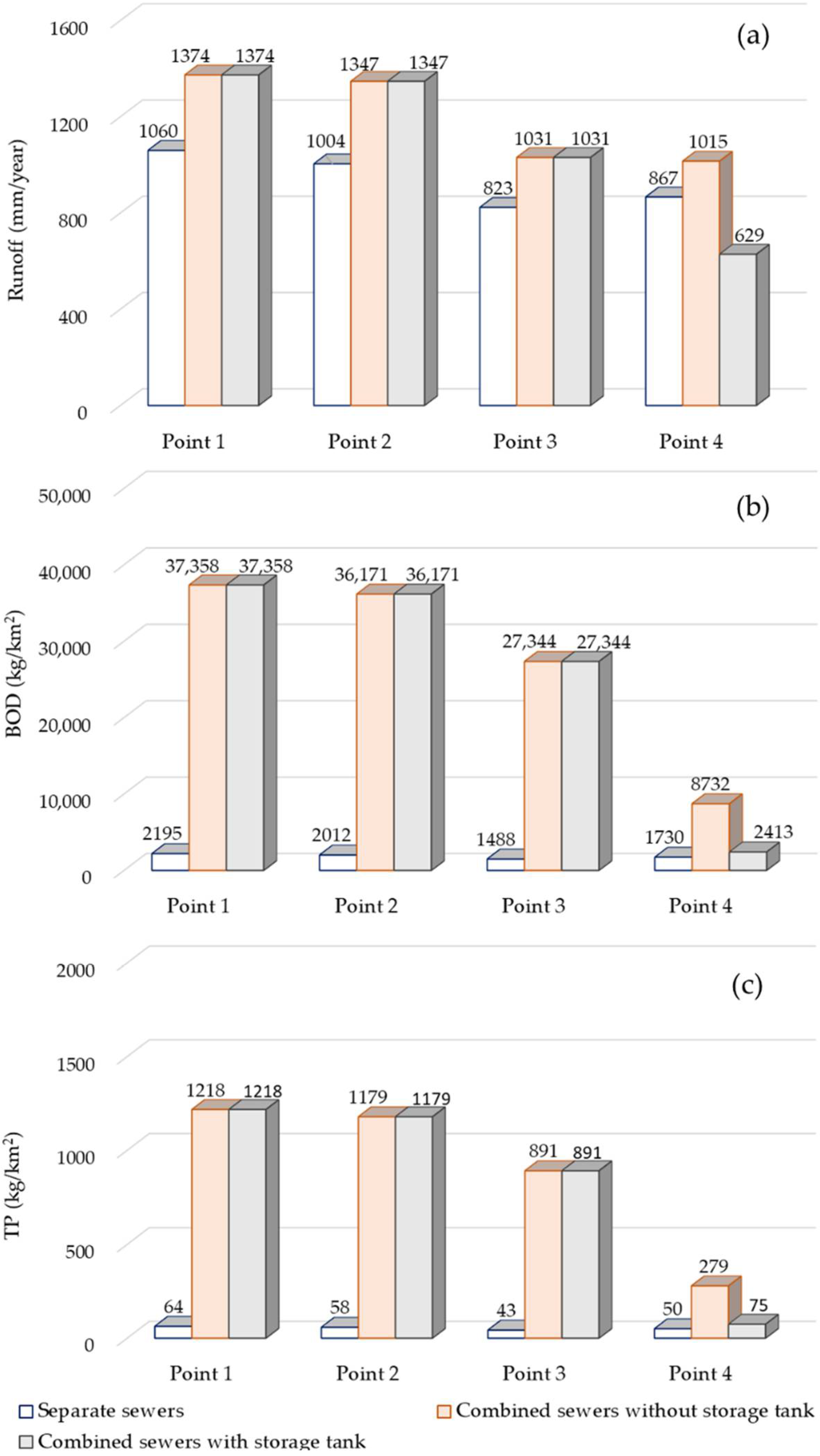
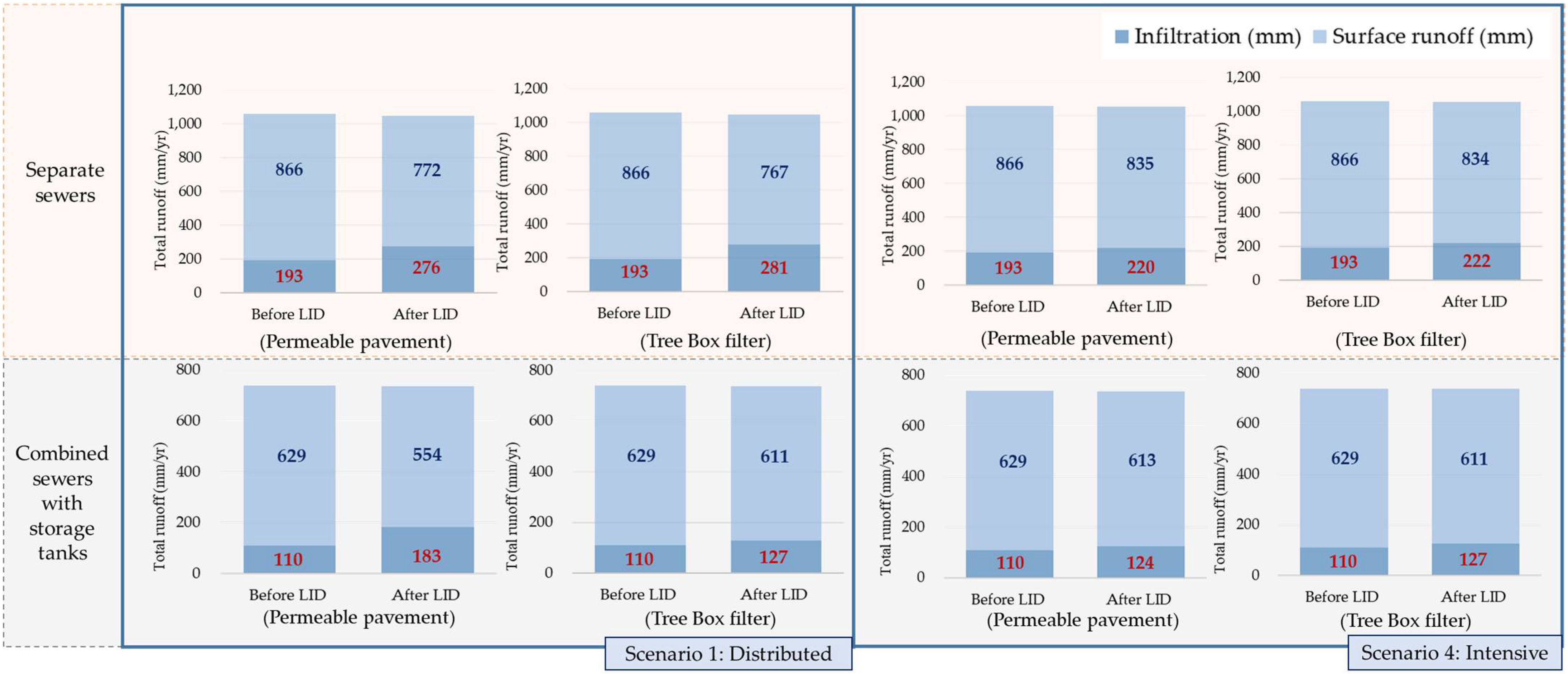
| LID Facilities | Grass Channel | Green Rooftop | Infiltration | Permeable Pavement | Rooftop Disconnection |
|---|---|---|---|---|---|
| Runoff Reduction (%) | 10 to 20 | 45 to 60 | 50 to 90 | 45 to 75 | 25 to 50 |
| Layer | Parameter | Permeable Pavement | Tree Box Filter |
|---|---|---|---|
| Surface | Berm height (mm) | 100 | 100 |
| Vegetation volume fraction | 0 | 0 | |
| Surface roughness | 0.012 | 0.13 | |
| Surface slope (%) | 2 | 1 | |
| Swale side slope | 5 | 5 | |
| Pavement | Thickness (mm) | 60 | Not applicable |
| Void ratio (voids/solids) | 0.2 | ||
| Impervious surface fraction | 0 | ||
| Permeability (mm/h) | 13 | ||
| Clogging factor | 0 | ||
| Soil | Thickness (mm) | Not applicable | 800 |
| Porosity | 0.437 | ||
| Field capacity | 0.062 | ||
| Wilting point | 0.024 | ||
| Conductivity (mm/h) | 120 | ||
| Conductivity slope | 30 | ||
| Suction head (mm) | 49 | ||
| Storage | Thickness (mm) | 200 | 300 |
| Void ratio (voids/solids) | 0.5 | 0.5 | |
| Seepage rate (mm/h) | 13 | 13 | |
| Clogging factor | 0 | 0 |
| Item | Scenario | Classification | Separate Sewers | Combined Sewers with Storage Tank | Combined Sewers without Storage Tank | ||||
|---|---|---|---|---|---|---|---|---|---|
| Permeable Pavement | Tree Box Filter | Permeable Pavement | Tree Box Filter | Permeable Pavement | Tree Box Filter | ||||
| Runoff (mm) | 1 | Distributed | 92.9 | 98.5 | 93.7 | 100.6 | 114.2 | 121.2 | |
| 2 | Intensive | Upstream | 41.0 | 42.3 | 19.2 | 20.6 | 23.6 | 25.0 | |
| 3 | Midstream | 39.3 | 40.8 | 18.9 | 20.4 | 23.3 | 24.8 | ||
| 4 | Downstream | 46.4 | 48.0 | 22.6 | 24.4 | 28.0 | 30.0 | ||
| BOD (kg/km2) | 1 | Distributed | 192.3 | 204.0 | 250.7 | 263.4 | 435.7 | 450.6 | |
| 2 | Intensive | Upstream | 66.6 | 69.3 | 61 | 64 | 84.6 | 87.8 | |
| 3 | Midstream | 63.3 | 66.7 | 59 | 63 | 83.2 | 86.9 | ||
| 4 | Downstream | 77.3 | 80.7 | 78 | 82 | 104.0 | 107.1 | ||
| TP (kg/km2) | 1 | Distributed | 5.6 | 5.9 | 8.1 | 8.5 | 14.1 | 14.6 | |
| 2 | Intensive | Upstream | 1.9 | 2.0 | 1.9 | 2.0 | 2.7 | 2.8 | |
| 3 | Midstream | 1.8 | 2.0 | 1.8 | 1.9 | 2.6 | 2.7 | ||
| 4 | Downstream | 2.2 | 2.3 | 2.4 | 2.5 | 3.4 | 3.5 | ||
Publisher’s Note: MDPI stays neutral with regard to jurisdictional claims in published maps and institutional affiliations. |
© 2022 by the authors. Licensee MDPI, Basel, Switzerland. This article is an open access article distributed under the terms and conditions of the Creative Commons Attribution (CC BY) license (https://creativecommons.org/licenses/by/4.0/).
Share and Cite
Lee, J.; Kim, J.; Lee, J.M.; Jang, H.S.; Park, M.; Min, J.H.; Na, E.H. Analyzing the Impacts of Sewer Type and Spatial Distribution of LID Facilities on Urban Runoff and Non-Point Source Pollution Using the Storm Water Management Model (SWMM). Water 2022, 14, 2776. https://doi.org/10.3390/w14182776
Lee J, Kim J, Lee JM, Jang HS, Park M, Min JH, Na EH. Analyzing the Impacts of Sewer Type and Spatial Distribution of LID Facilities on Urban Runoff and Non-Point Source Pollution Using the Storm Water Management Model (SWMM). Water. 2022; 14(18):2776. https://doi.org/10.3390/w14182776
Chicago/Turabian StyleLee, Jimin, Jinsun Kim, Jong Mun Lee, Hee Seon Jang, Minji Park, Joong Hyuk Min, and Eun Hye Na. 2022. "Analyzing the Impacts of Sewer Type and Spatial Distribution of LID Facilities on Urban Runoff and Non-Point Source Pollution Using the Storm Water Management Model (SWMM)" Water 14, no. 18: 2776. https://doi.org/10.3390/w14182776
APA StyleLee, J., Kim, J., Lee, J. M., Jang, H. S., Park, M., Min, J. H., & Na, E. H. (2022). Analyzing the Impacts of Sewer Type and Spatial Distribution of LID Facilities on Urban Runoff and Non-Point Source Pollution Using the Storm Water Management Model (SWMM). Water, 14(18), 2776. https://doi.org/10.3390/w14182776








